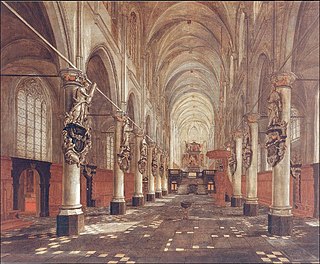
The Elevation of the Cross is the name of two paintings, a very large triptych in oil on panel and a much smaller oil on paper painting. Both pieces were painted by the Flemish artist Peter Paul Rubens in Antwerp, Belgium, the original in 1610 and the latter in 1638.

Cornelis de Vos was a Flemish painter, draughtsman and art dealer. He was one of the leading portrait painters in Antwerp and is best known for his sensitive portraits, in particular of children and families. He was also successful in other genres including history, religious and genre painting. He was a regular collaborator with Rubens.

Venus and Cupid with a Satyr is a painting by the Italian High Renaissance] artist Antonio da Correggio. It is now in the Musée du Louvre in Paris.

Jacob Adriaensz Backer was a Dutch Golden Age painter. He produced about 140 paintings in twenty years, including portraits, religious subjects, and mythological paintings. In his style, he was influenced by Wybrand de Geest, Rubens and Abraham Bloemaert. He is also noted for his drawings of male and female nudes.
Gaspar Roomer was a prominent Flemish merchant, banker, art patron and art collector who was active in Naples in the 17th century.
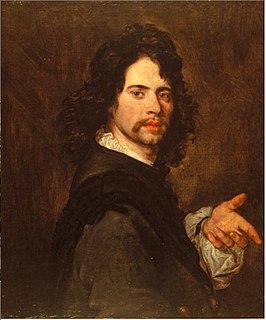
Jan van den Hoecke was a Flemish painter, draughtsman and designer of wall tapestries. He was one of the principal assistants in Rubens' studio in the 1630s. He later traveled to Italy where he resided for a decade in Rome. He subsequently worked as a court painter in Vienna and Brussels. Jan van den Hoecke was a versatile artist who created portraits as well as history and allegorical paintings.

Peter Snayers or Pieter Snayers (1592–1667) was a Flemish painter known for his panoramic battle scenes, depictions of cavalry skirmishes, attacks on villages, coaches and convoys and hunting scenes. He established his reputation mainly through his topographic battle scenes providing a bird's eye view over the battlefield. He further painted large landscapes and portraits of the aristocracy. He was a regular collaborator of local landscape painters and also Rubens.

Willem van Haecht was a Flemish painter best known for his pictures of art galleries and collections.

Jan Boeckhorst or Johann Bockhorst was a German-born Flemish Baroque painter and draughtsman. He was a versatile artist who produced history paintings, genre scenes and portraits in a style influenced by the trio of leading Baroque painters in Antwerp Peter Paul Rubens, Anthony van Dyck and Jacob Jordaens. Boeckhorst also worked as a designer of cartoons for tapestries.

Daniël Seghers or Daniel Seghers was a Flemish Jesuit brother and painter who specialized in flower still lifes. He is particularly well known for his contributions to the genre of flower garland painting. His paintings were collected enthusiastically by aristocratic patrons and he had numerous followers and imitators.

Jan Wildens was a Flemish painter and draughtsman specializing in landscapes. His Realist landscapes show an eye for detail and have a serene character. He was a regular collaborator with Rubens and other leading Flemish Baroque painters of his generation in whose compositions he painted the landscapes.
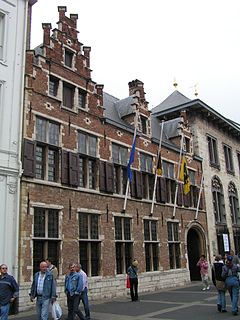
The Rubenshuis is the former home and workshop of Peter Paul Rubens (1577–1640) in Antwerp. Purchased in 1610, Rubens had the Flemish townhouse renovated and extended on the basis of designs by Rubens himself. After the renovations the house and its courtyard garden had the outlook of an Italian palazzo, which reflected Rubens' artistic ideals. The ensemble is now a museum dedicated mainly to the work of Rubens and his contemporaries.

Sir Peter Paul Rubens was a Flemish artist and diplomat from the Duchy of Brabant in the Southern Netherlands. He is considered the most influential artist of the Flemish Baroque tradition. Rubens's highly charged compositions reference erudite aspects of classical and Christian history. His unique and immensely popular Baroque style emphasized movement, colour, and sensuality, which followed the immediate, dramatic artistic style promoted in the Counter-Reformation. Rubens was a painter producing altarpieces, portraits, landscapes, and history paintings of mythological and allegorical subjects. He was also a prolific designer of cartoons for the Flemish tapestry workshops and of frontispieces for the publishers in Antwerp.

Venus Blindfolding Cupid is a c.1565 painting by Titian, now in the Galleria Borghese in Rome.
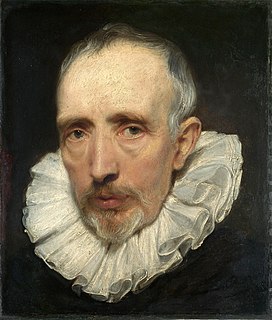
Cornelis van der Geest was a spice merchant from Antwerp, who used his wealth to support the Antwerp artists and to establish his art collection. He was also the dean of the haberdashers guild.
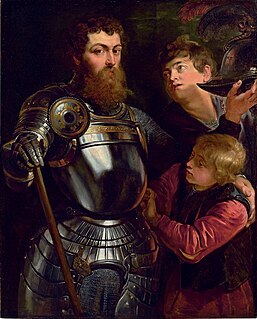
Portrait of a Commander or A Commander Being Dressed for Battle is a portrait of an unknown man in plate armour, by Peter Paul Rubens. In July 2010 it was sold for £9 million by Christie's after Sotheby's turned it down, suspecting its authenticity as a Rubens. In December 2011, the portrait was placed on loan with the Metropolitan Museum of Art in New York.

The Reconciliation of Esau and Jacob is a 1624 painting by Peter Paul Rubens. Originally in the Spanish royal collection, it was sent to Germany by Maria Anna of Neuburg to her brother Johann Wilhelm. It is now in the Staatsgalerie Schleissheim near Munich.

Samson and Delilah is a 1630 painting by Anthony van Dyck. Like his 1620 version of the subject, it is in the style of his former master Peter Paul Rubens. Unlike Rubens, however, van Dyck shows Delilah seemingly appalled at her own betrayal of Samson and regretting her act of treason, whereas Rubens showed him as a captive and her as an unscrupulous temptress. Van Dyck's palette in the work also reveals the influence of Titian during van Dyck's stay in Italy. It is now in the Kunsthistorisches Museum in Vienna.

Madonna and Child Kissing is a 1520s oil on panel painting by the Flemish renaissance artist Quentin Matsys in the collection of the Rijksmuseum, Amsterdam, on loan to the Mauritshuis.

The Money Changer and His Wife is a 1514 oil on panel painting by the Flemish renaissance artist Quentin Matsys.





















